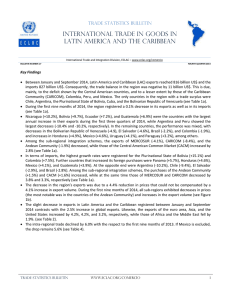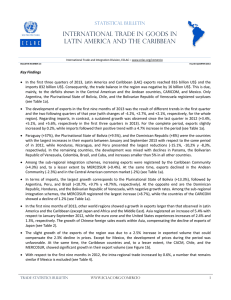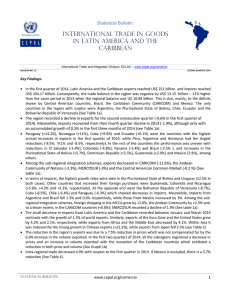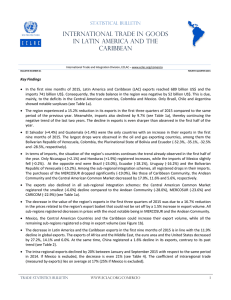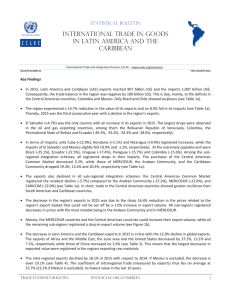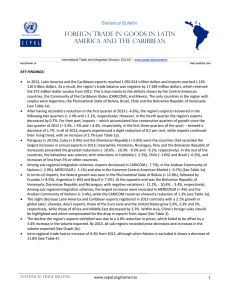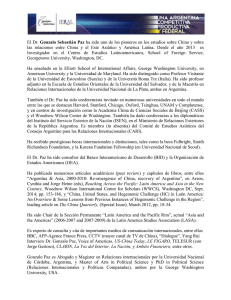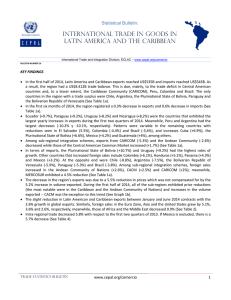bulletin_first_quarter_2015_no18 PDF | 958.5 Kb
Anuncio
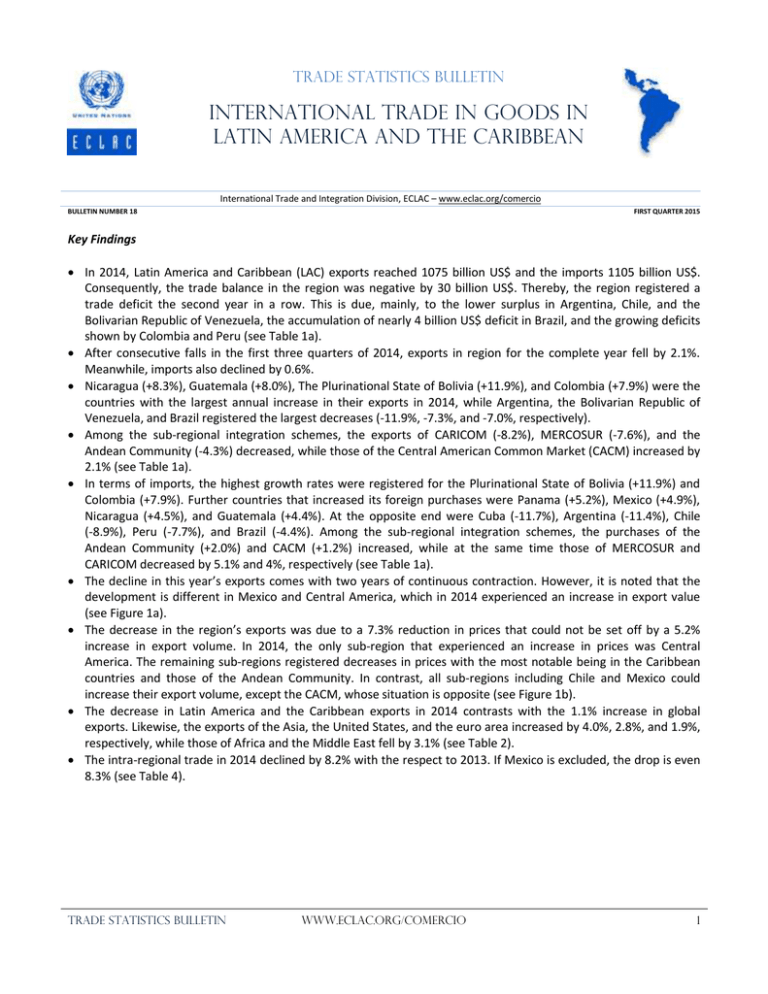
Trade Statistics Bulletin International Trade in Goods in Latin America and the Caribbean International Trade and Integration Division, ECLAC – www.eclac.org/comercio BULLETIN NUMBER 18 FIRST QUARTER 2015 Key Findings In 2014, Latin America and Caribbean (LAC) exports reached 1075 billion US$ and the imports 1105 billion US$. Consequently, the trade balance in the region was negative by 30 billion US$. Thereby, the region registered a trade deficit the second year in a row. This is due, mainly, to the lower surplus in Argentina, Chile, and the Bolivarian Republic of Venezuela, the accumulation of nearly 4 billion US$ deficit in Brazil, and the growing deficits shown by Colombia and Peru (see Table 1a). After consecutive falls in the first three quarters of 2014, exports in region for the complete year fell by 2.1%. Meanwhile, imports also declined by 0.6%. Nicaragua (+8.3%), Guatemala (+8.0%), The Plurinational State of Bolivia (+11.9%), and Colombia (+7.9%) were the countries with the largest annual increase in their exports in 2014, while Argentina, the Bolivarian Republic of Venezuela, and Brazil registered the largest decreases (-11.9%, -7.3%, and -7.0%, respectively). Among the sub-regional integration schemes, the exports of CARICOM (-8.2%), MERCOSUR (-7.6%), and the Andean Community (-4.3%) decreased, while those of the Central American Common Market (CACM) increased by 2.1% (see Table 1a). In terms of imports, the highest growth rates were registered for the Plurinational State of Bolivia (+11.9%) and Colombia (+7.9%). Further countries that increased its foreign purchases were Panama (+5.2%), Mexico (+4.9%), Nicaragua (+4.5%), and Guatemala (+4.4%). At the opposite end were Cuba (-11.7%), Argentina (-11.4%), Chile (-8.9%), Peru (-7.7%), and Brazil (-4.4%). Among the sub-regional integration schemes, the purchases of the Andean Community (+2.0%) and CACM (+1.2%) increased, while at the same time those of MERCOSUR and CARICOM decreased by 5.1% and 4%, respectively (see Table 1a). The decline in this year’s exports comes with two years of continuous contraction. However, it is noted that the development is different in Mexico and Central America, which in 2014 experienced an increase in export value (see Figure 1a). The decrease in the region’s exports was due to a 7.3% reduction in prices that could not be set off by a 5.2% increase in export volume. In 2014, the only sub-region that experienced an increase in prices was Central America. The remaining sub-regions registered decreases in prices with the most notable being in the Caribbean countries and those of the Andean Community. In contrast, all sub-regions including Chile and Mexico could increase their export volume, except the CACM, whose situation is opposite (see Figure 1b). The decrease in Latin America and the Caribbean exports in 2014 contrasts with the 1.1% increase in global exports. Likewise, the exports of the Asia, the United States, and the euro area increased by 4.0%, 2.8%, and 1.9%, respectively, while those of Africa and the Middle East fell by 3.1% (see Table 2). The intra-regional trade in 2014 declined by 8.2% with the respect to 2013. If Mexico is excluded, the drop is even 8.3% (see Table 4). TRADE Statistics BULLETIN www.eclac.org/comercio 1 A – Trade by Origin and Destination Table 1. Latin America and the Caribbean: Trends in Goods Exports. (Millions of current US$ and growth rates in percentages) a) Accumulated, January - December Exports 71 935 12 856 225 101 75 675 54 795 11 304 8 499 9 919 25 732 5 273 10 833 4 070 397 535 2 599 818 9 657 38 162 9 167 82 401 1 074 867 131 545 18 536 34 897 398 261 Argentina Bolivia, Plurinational State of Brazil Chile Colombia Costa Rica Cuba Dominican Republic Ecuador El Salvador Guatemala Honduras Mexico Nicaragua Panama Paraguay Peru Uruguay Venezuela, Bolivarian Republic of Latin America and the Caribbean Andean Community (ANC) Caribbean Community (CARICOM) Central American Common Market (CACM) Southern Common Market (MERCOSUR) January-December 2014 Import 65 249 9 782 229 031 67 908 64 060 17 186 7 741 13 903 27 740 10 513 18 276 9 311 399 977 5 876 13 715 11 299 39 937 11 485 57 052 1 105 109 141 519 25 069 74 877 374 116 Growth rate Balance 6 686 3 074 -3 930 7 767 -9 266 -5 882 759 -3 984 -2 007 -5 240 -7 443 -5 241 -2 442 -3 278 -12 896 -1 643 -1 775 -2 317 25 349 -30 242 -9 974 -6 533 -39 980 24 146 Exports Imports -11.4 11.9 -4.4 -8.9 7.9 -4.6 -11.7 1.5 1.6 -2.4 4.4 2.9 4.9 4.5 5.2 0.0 -7.7 -1.4 -1.7 -0.6 2.0 -4.0 1.2 -5.1 -11.9 5.3 -7.0 -1.3 -6.8 -2.1 -3.9 4.4 3.1 -4.0 8.0 4.7 4.6 8.3 -3.0 2.4 -8.1 1.1 -7.3 -2.1 -4.3 -8.2 2.1 -7.6 b) Exports, January - December 2014 Argentina Bolivia, P.S. Brazil Chile Colombia Costa Rica Cuba Dominican Republic Ecuador El Salvador Guatemala Honduras Mexico Nicaragua Panama Paraguay Peru Uruguay Venezuela, B.R. Latin America and the Caribbean ANC CARICOM CACM MERCOSUR Jan-14 5 231 1 013 16 026 5 504 4 809 857 801 740 2 016 403 835 341 27 052 221 59 734 3 062 594 8 644 Feb-14 5 393 1 024 15 934 6 227 4 271 967 626 790 2 168 412 806 328 30 462 203 61 864 3 226 481 6 904 Mar-14 5 253 1 145 17 628 7 308 4 408 1 043 672 873 2 452 474 1 035 359 33 236 258 71 951 3 169 705 7 511 Apr-14 6 398 1 054 19 724 6 640 4 317 984 684 818 1 884 422 940 362 34 071 215 65 1 091 3 027 738 7 011 May-14 7 117 1 204 20 752 6 891 5 496 1 065 742 907 2 604 488 947 412 34 383 230 68 982 3 024 1 094 7 216 Jun-14 7 387 1 162 20 467 6 097 4 698 987 715 801 2 303 469 892 362 33 474 238 86 889 3 142 1 086 6 813 Jul-14 6 723 1 188 23 024 6 333 5 049 950 715 863 2 138 486 949 390 33 711 218 76 763 3 272 1 052 6 585 Aug-14 6 599 1 144 20 463 5 918 4 813 957 736 845 2 288 434 874 303 33 361 218 73 793 3 518 820 6 495 Sep-14 6 016 1 109 19 617 5 810 5 069 919 739 839 2 104 434 885 281 34 256 207 72 749 3 273 722 6 436 Oct14 5 967 1 000 18 330 6 141 4 302 977 717 876 2 077 425 880 301 37 086 197 75 714 3 255 640 6 654 Nov-14 5 279 923 15 646 5 744 3 795 809 631 738 2 030 423 853 269 32 329 195 54 601 3 045 609 6 085 Dec-14 4 573 889 17 491 7 064 3 768 788 721 829 1 668 403 937 361 34 114 200 60 526 3 149 626 6 048 80 294 10 900 1 351 2 717 31 229 82 618 10 689 1 472 2 777 29 576 90 343 11 174 1 792 3 239 32 048 92 260 10 282 1 814 2 989 34 962 97 258 12 328 1 637 3 210 37 161 93 532 11 305 1 465 3 033 36 641 96 254 11 647 1 769 3 069 38 147 92 298 11 763 1 646 2 859 35 170 90 934 11 555 1 398 2 798 33 540 91 971 10 635 1 358 2 855 32 305 81 430 9 793 1 373 2 602 28 219 85 675 9 474 1 460 2 749 29 263 TRADE Statistics BULLETIN www.eclac.org/comercio 2 c) Imports, January - December 2014 Argentina Bolivia, P.S. Brazil Chile Colombia Costa Rica Cuba Dominican Republic Ecuador El Salvador Guatemala Honduras Mexico Nicaragua Panama Paraguay Peru Uruguay Venezuela, B.R. Jan-14 5 196 779 20 085 6 080 4 844 1 520 646 1 041 2 337 905 1 548 680 30 234 473 1 076 868 3 536 1 079 5 279 Feb-14 5 349 764 18 063 5 299 5 003 1 375 654 944 1 972 814 1 356 699 29 543 409 1 033 855 2 910 825 4 328 Mar-14 5 211 689 17 515 5 544 4 912 1 624 703 1 189 2 168 896 1 475 791 32 287 447 1 061 865 3 316 1 127 4 821 Apr-14 5 472 749 19 218 5 807 5 455 1 491 663 1 268 2 211 904 1 521 771 33 562 446 1 221 896 3 511 822 4 514 May-14 5 858 738 20 037 5 440 5 423 1 553 668 1 270 2 447 973 1 668 872 34 251 493 1 123 915 3 419 1 051 4 859 Jun-14 6 008 724 18 105 5 527 4 955 1 360 647 1 160 2 243 879 1 443 788 33 051 496 1 170 888 3 230 1 024 4 828 Jul-14 5 920 915 21 450 5 943 6 084 1 400 624 1 212 2 338 926 1 620 793 34 691 499 1 069 1 044 3 520 947 4 813 Aug-14 5 700 883 19 300 5 642 4 902 1 435 648 1 201 2 389 776 1 462 812 34 484 503 1 072 1 002 3 502 850 4 811 Sep-14 5 612 889 20 556 5 420 5 791 1 404 625 1 115 2 290 833 1 541 782 33 666 448 1 316 999 3 318 990 4 821 Oct14 5 606 943 19 507 5 779 5 847 1 397 628 1 226 2 565 901 1 575 761 36 943 577 1 349 1 090 3 481 1 022 4 857 Nov-14 4 818 827 17 996 5 273 5 354 1 319 599 1 133 2 388 877 1 556 790 33 405 545 1 092 905 3 168 904 4 615 Dec-14 4 499 883 17 198 6 153 5 489 1 306 637 1 145 2 391 829 1 510 771 33 861 539 1 132 975 3 026 844 4 505 Latin America and the Caribbean 90 319 84 063 88 940 92 469 94 960 90 738 98 069 93 397 94 563 98 257 89 542 89 792 ANC 11 497 10 649 11 086 11 927 12 027 11 151 12 856 11 675 12 288 12 836 11 738 11 789 CARICOM 2 113 1 868 2 297 1 965 1 901 2 215 2 262 2 024 2 146 2 201 1 978 2 098 CACM 6 202 5 687 6 295 6 355 6 682 6 136 6 308 6 060 6 325 6 561 6 179 6 087 MERCOSUR 32 506 29 420 29 539 30 922 32 720 30 852 34 174 31 663 32 978 32 083 29 237 28 021 Source: ECLAC based on data from Statistical Offices, Central Banks, Export Promotion Agencies, the United States International Trade Commission (USITC), EUROSTAT of the European Union, Statistics Canada, the International Monetary Fund Direction of Trade Statistics (DOTS), and the Central American Monetary Council. Notes: Data for the Bolivarian Republic of Venezuela beginning in January 2014 are estimated based on mirror statistics from its main trading partners; for the period JulyDecember 2014, the monthly DOTS trends are applied. Data for Cuba and the CARICOM countries are estimated based on mirror statistics. Data for Honduras and Nicaragua do not include maquila. Data for the Dominican Republic for May 2014 are estimated. MERCOSUR data include the Bolivarian Republic of Venezuela and those of CACM include Panama. Figure 1. Latin America and the Caribbean: Trends in Exports, January - December 2014 a) Change compared to previous year (in percentages) -2,4 Caribbean Countries 4,2 0,5 1,8 Central America 0,1 -2,1 -3,6 -2,9 -2,3 Latin America and the Caribbean -2,1 -4 2014 -1,1 -2 2 4 6 -6,0 3,1 -7,3 -20 -10 Price 2013 8,2 -5,6 2,0 Latin America and the Caribbean 0 1,2 -10,4 South America -0,3 -6 -2,7 4,4 MERCOSUR -1,8 8,5 -4,3 Andean Community -3,8 South America Mexico Chile -2,0 MERCOSUR 8,8 -11,2 Central America -2,0 Chile Decomposition of growth in price and volume compared to previous year (in percentages) Caribbean Countries 2,0 Mexico Andean Community b) 5,2 0 10 20 Volume Source: ECLAC based on data from Statistical Offices, Central Banks, Export Promotion Agencies, USITC, EUROSTAT, and DOTS. Notes: Data for the Bolivarian Republic of Venezuela beginning in January 2014 are estimated based on mirror statistics from its main trading partners; for the period JulyDecember 2014, the monthly DOTS trends are applied. Data for countries in the Caribbean (Cuba and CARICOM) are estimated based on mirror statistics. Cuba’s deflator is built based on the volume imported by the European Union; the Caribbean’s deflator is built based on the deflators reported by Guyana and Jamaica to the IMF. CACM data do not include Panama; they also do not include maquila for Honduras and Nicaragua. MERCOSUR data include the Bolivarian Republic of Venezuela. TRADE Statistics BULLETIN www.eclac.org/comercio 3 The negative growth rate of the region’s exports in 2014 contrasts with the global increase in exports. Among world regions, only Africa and the Middle East registered a larger decline than that of Latin America and the Caribbean (see Table 2 and Figure 2). Figure 2 and Table 2. Latin America and the Caribbean and Selected Regions: Trends in Value of Exports, January 2006 - December 2014 Latin America and Caribbean Exports: Main Destinations (January 2006 index =100) 1200 1000 800 600 Growth Compared to Other Regions (Accumulated for each year, in percentages) Growth 2012 United States European Union China Other Asia Latin America and the Caribbean Latin America and the Caribbean Africa and the Middle East Asia China Japan Euro area United States World 400 200 0 Growth 2013 1.7 0.9 3.2 7.9 -2.6 -4.5 4.7 -0.3 -0.3 -2.3 5.5 7.8 -10.0 3.5 2.3 2.4 Growth 2014 -2.1 -3.1 4.0 6.0 -3.5 1.9 2.8 1.1 Source: ECLAC based on data from Statistical Offices, Central Banks, Export Promotion Agencies, USITC, EUROSTAT, Statistics Canada, DOTS, and CPB Netherlands Bureau for Economic Policy Analysis. Notes: Data for the Bolivarian Republic of Venezuela beginning in October 2013 are estimated based on mirror statistics from its main trading partners; for the period JulyDecember 2014, the monthly DOTS trends are applied. Data for Cuba and CARICOM are estimated based on mirror statistics. Figure 2 does not include Panama and the Dominican Republic; it does also not include maquila for Honduras and Nicaragua. In 2014, the main export destinations of Latin America and the Caribbean were the United States (41.9%), Asia (18.0%), and the region itself (17.9%). As regards imports, the United States also were the main source (30.9%), followed by Asia (27.1%) and the region itself (17.5%) (see Table 3). Table 3. Latin America and the Caribbean: Trade with Main Partners, January - December 2014 (Millions of current US$) Exports United States European Union Asia China Other Asia Latin America and the Caribbean Rest of the World Jan-14 79 502 32 630 8 807 14 600 7 280 7 320 14 901 8 564 Feb-14 81 810 34 493 9 062 14 759 7 181 7 578 14 970 8 528 Mar-14 89 430 36 881 9 526 17 452 8 790 8 662 16 572 8 999 Apr-14 91 416 37 812 10 515 16 558 9 017 7 541 15 628 10 903 May-14 96 309 38 292 11 711 18 525 9 742 8 783 17 281 10 499 Jun-14 92 645 37 188 10 927 17 817 9 262 8 555 15 741 10 972 Jul-14 95 314 39 094 10 605 17 278 7 995 9 283 17 025 11 312 Aug-14 91 371 37 437 10 483 16 523 8 326 8 196 16 157 10 771 Sep-14 90 013 38 033 9 842 15 901 7 558 8 343 16 158 10 079 Oct14 91 018 41 111 9 524 14 608 6 220 8 389 16 466 9 308 Nov-14 80 567 35 152 8 432 13 095 5 653 7 442 15 110 8 778 Dec-14 Share % 84 711 100.0 37 836 41.9 8 723 11.1 14 882 18.0 6 387 8.8 8 495 9.3 14 745 17.9 8 525 11.0 Imports 88 202 82 087 86 690 89 954 92 519 88 366 95 778 91 128 92 169 95 697 87 565 87 675 100.0 United States 26 510 25 426 27 750 27 250 28 271 27 298 28 477 28 189 28 409 29 884 27 618 27 512 30.9 European Union 12 000 10 862 12 279 12 978 12 289 11 704 13 417 12 662 12 259 12 422 11 736 11 777 13.6 Asia 24 651 21 219 21 522 23 161 24 209 21 721 26 030 25 572 26 033 28 216 24 932 25 012 27.1 China 14 069 11 757 11 495 12 578 13 504 12 263 15 271 15 046 15 090 16 661 14 383 14 578 15.5 Other Asia 10 519 9 414 9 972 10 545 10 652 9 382 10 748 10 422 10 770 11 468 10 389 10 071 11.5 Latin America and the Caribbean 15 556 15 057 16 039 16 196 16 972 15 363 16 993 15 269 15 557 16 088 14 590 14 421 17.5 Rest of the World 9 485 9 522 9 101 10 369 10 777 12 279 10 861 9 436 9 911 9 088 8 690 8 955 11.0 Source: ECLAC based on data from Statistical Offices, Central Banks, Export Promotion Agencies, USITC, EUROSTAT, Statistics Canada, and DOTS. Notes: Includes data from Argentina, the Plurinational State of Bolivia, Brazil, Chile, Colombia, Costa Rica, Cuba, Ecuador, El Salvador, Guatemala, Honduras, Mexico, Nicaragua, Paraguay, Peru, Uruguay, the Bolivarian Republic of Venezuela, and CARICOM. It does not include maquila for Honduras and Nicaragua. Data for Cuba and CARICOM are estimated based on mirror statistics of the United States, the European Union, Canada, and the rest of Latin America. In the case of the Bolivarian Republic of Venezuela, the total was disaggregated utilizing mirror statistics from the United States, the European Union, Japan, Chile, the rest of the MERCOSUR countries, the Andean Community, Mexico, Costa Rica, Guatemala, and Nicaragua; DOTS structure was used for the rest of the destinations. The intra-regional exports in 2014 decreased by 8.2%. Likewise, those to Asia and the European Union decreased by 7.3% and 6.3%, respectively. Meanwhile, exports to the United States increased by 3.2%. At the imports side, the greatest dynamic is observed in those coming from the United States (+1.6%) and Asia (+0.5), particularly from China (+1.7%). TRADE Statistics BULLETIN www.eclac.org/comercio 4 Table 4. Latin America: Intra-Subregional and Intra-Regional Trade, January - December 2014 (Percentages of total exports and growth rates) Jan-14 Feb-14 Mar-14 Apr-14 May-14 Jun-14 Jul-14 Aug-14 Sep-14 Intra CAN 6.8 7.2 8.5 7.1 7.2 7.0 6.7 7.8 7.6 Intra CACM 23.9 23.5 23.2 22.9 22.9 24.1 24.0 24.6 24.5 Intra MERCOSUR 14.0 14.7 13.7 12.2 13.0 12.1 12.2 12.6 13.9 Chile to LAC 17.0 18.1 16.9 17.7 18.9 18.8 18.6 19.6 20.2 Mexico to LAC 6.0 6.2 6.8 6.5 6.9 6.4 6.6 6.4 6.4 Intra LAC 18.7 18.3 18.5 17.1 17.9 17.0 17.9 17.7 18.0 Intra LAC w/o Mexico 25.3 25.5 25.5 23.4 24.1 23.0 24.0 24.2 25.0 Source: ECLAC based on data from Statistical Offices, Central Banks, Export Promotion Agencies, USITC, EUROSTAT, and DOTS. Note: It does not include maquila for Honduras and Nicaragua. MERCOSUR data include the Bolivarian Republic of Venezuela. a Growth rates with respect to the same period of the previous year. Oct14 7.9 26.1 14.7 22.4 6.2 18.1 26.3 Nov-14 7.6 26.8 15.7 21.3 6.0 18.8 27.3 Growth a Dec-14 J-D 14/J-D 13 8.0 -2.4 23.7 13.8 14.1 -12.7 16.8 -2.3 5.8 -7.6 17.4 -8.2 25.2 -8.3 In 2014, the largest share of intra-regional trade was observed in the Central American Common Market (24.2%), the only sub-region whose coefficient lay above the aggregated one for whole Latin America and the Caribbean (17.9%). The Andean Community (CAN) remains the grouping with the lowest coefficient of intra-subregional trade (7.4%). Moreover, the negative growth recorded for the exports of Chile and Mexico to the region (-2.3% and -7.6%, respectively) and for the intra-MERCOSUR (-12.7%) and intra-CAN trade (-2.4%) should be highlighted (see Table 4). B – Trade by Category and Main Products Table 5. Latin America and the Caribbean: Main Traded Product Categories, January - December 2014 (Millions of current US$) EXPORTS Agriculture and Livestock Mining and Petroleum Manufactures Jan-14 79 014 10 153 26 379 42 482 Feb-14 80 636 9 395 25 481 45 760 Mar-14 87 999 10 274 26 512 51 212 Apr-14 90 033 11 488 24 850 53 695 May-14 94 889 11 936 27 841 55 112 Jun-14 91 818 11 552 26 832 53 434 Jul-14 94 271 11 570 27 175 55 525 Aug-14 88 846 10 964 25 411 52 471 Sep-14 88 936 10 011 25 686 53 240 Oct14 89 930 10 949 24 041 54 940 Nov-14 79 797 9 634 22 164 47 999 Dec-14 79 468 10 678 22 412 46 378 Share % 100.0 12.3 29.1 58.6 IMPORTS 88 124 82 057 86 520 90 703 92 840 88 099 95 672 89 272 90 759 94 487 85 859 83 980 100.0 Capital Goods 16 895 14 623 15 244 15 913 15 917 15 042 16 675 15 092 15 733 17 279 16 174 16 543 17.9 Intermediate Inputs 41 496 40 031 43 407 44 338 47 512 43 838 47 735 46 318 45 594 47 614 41 901 42 186 49.8 Consumption Goods 16 779 15 547 16 001 17 065 16 929 16 101 17 524 16 545 17 472 18 276 16 853 16 233 18.8 Fuels 12 954 11 856 11 869 13 388 12 483 13 119 13 738 11 317 11 960 11 318 10 931 9 018 13.5 Source: ECLAC based on data from Statistical Offices, Central Banks, Export Promotion Agencies, USITC, and EUROSTAT. Note: Includes data from Argentina, the Plurinational State of Bolivia, Brazil, Chile, Colombia, Costa Rica, Ecuador, El Salvador, Guatemala, Honduras, Mexico, Nicaragua, Panama, Paraguay, Peru, the Dominican Republic, Uruguay, and the Bolivarian Republic of Venezuela. It does not include maquila for Honduras and Nicaragua. Data for the Bolivarian Republic of Venezuela beginning in October 2013 are estimated based on mirror statistics from its main trading partners that were assumed to have repeating shares in the same category in the same month of the previous year; for the period July-December 2014, the monthly DOTS trends are applied. By product categories, the largest changes in 2014 with respect to the previous year were registered in the exports of mining and petroleum (6.2% decrease) and, to a lesser extent, of agricultural and livestock products (1.4% drop). Meanwhile, the exports of manufactured goods that alone accounted for 58.6% of total exports in 2014 had zero growth. The decline in export value can be mainly explained by the change in minerals and oil prices, which together represent about 37% of the total exports. Likewise, the Latin American commodities price index fell by 8.3% (see Table 6.b), with declines in products such as gas, iron, copper, sugar, and soy. In terms of export volume, the heavy losses in gas, meat, sugar, and oil must be acknowledged, as well as the reported increase in exported iron (see Table 6a). TRADE Statistics BULLETIN www.eclac.org/comercio 5 Table 6. Latin America and the Caribbean: Main Products Exported, January - December 2014 (Millions of current US$, percentages and price indices 2010=100) a) Selected Products b) Product Groups Value Prices Volume Prices Jan-Dec Jan-Dec Value Dec Jan-Dec Jan-Dec Price change Jan-Dec Jan-Dec Price Dec (E) 2013 2014 change 2014 2013 2014 change 2013 2014 change 2014 Sugar 2% 15 196 12 244 -19.4 187.4 216.3 207.8 -3.9 -15.5 Foodstuff 10% 169.9 170.3 0.2 169.0 Banana 1% 4 078 4 389 7.6 216.5 220.8 222.1 0.6 7.0 Beverages 3% 124.7 166.9 33.9 109.8 Beverages (A) 3% 8 713 10 154 16.5 162.4 124.7 166.9 33.9 -17.3 Oils and 8% 207.5 188.8 -9.0 209.6 Meats 2% 23 835 26 185 9.9 272.9 209.1 255.2 22.0 -12.2 flours Copper 9% 52 707 48 969 -7.1 354.1 404.0 378.4 -6.4 -0.7 Other agro 9% 152.4 152.5 0.0 153.8 Gas 2% 8 204 7 726 -5.8 79.6 86.5 101.1 16.9 -22.7 Minerals and 27% 238.4 199.2 -16.4 234.5 Iron-Steel (B) 5% 14 386 15 001 4.3 251.8 488.9 352.3 -27.9 32.2 metals Oil 30% 169 939 150 086 -11.7 225.7 387.9 358.8 -7.5 -4.2 Fuels 45% 176.9 165.3 -6.6 176.6 Soy (C) 3% 29 185 30 545 4.7 210.5 257.2 232.3 -9.7 14.4 Sub-total 57% 326 242 305 299 -6.4 137.6 203.0 186.2 -8.3 1.9 Total 100% 191.4 175.5 -8.3 190.0 Source: ECLAC based on data from Statistical Offices, Central Banks, Export Promotion Agencies, CEPALSTAT and the World Bank. See description in the Excel spreadsheet in the Annex. Notes: Product statistics are made up by main exporters in the region and not with all countries; in each case, they represent more than 70% of the annual total in that product. In the case of prices, it is an index calculated by ECLAC. (A) Average of coffee, tea, and yerba mate; (B) Made up of iron and steel manufactures; (C) Soy grains; (D) Weight of each product in the total regional exports; (E) Weight of each group in natural resources and manufacturing exports in the region. Products (D) Recent Activities of the International Trade and Integration Division Publications La Alianza del Pacífico y el MERCOSUR: hacia la convergencia en la diversidad Oportunidades para el aprovechamiento del protocolo comercial entre Guatemala y Chile Panorama de la Inserción Internacional de Latin America and the Caribbean 2014: integración regional y cadenas de valor en un escenario externo desafiante Estudio sobre la complementariedad comercial entre Honduras y Uruguay Huella de carbono, exportaciones y estrategias empresariales frente al cambio climático Informe del cuarto Seminario internacional sobre la huella de carbono "Huella ambiental en las exportaciones de alimentos de América Latina: normativa internacional y prácticas empresariales" Integración regional: hacia una estrategia de cadenas de valor inclusivas Cadenas globales de valor y diversificación de exportaciones: el caso de Costa Rica Estudio sobre la complementariedad comercial entre Honduras y Uruguay Latin America's emergence in global services Promoción del comercio y la inversión con China: desafíos y oportunidades en la experiencia de las cámaras empresariales latinoamericanas La cooperación entre América Latina y la Unión Europea: una asociación para el desarrollo Panorama de la inserción internacional de Latin America and the Caribbean 2013 Strengthening biregional cooperation between Latin America and Asia-Pacific: the role of FEALAC Events Taller: Indicadores de Comercio Exterior y Política Comercial V Encuentro Regional: Análisis de Políticas Públicas con Modelos de Equilibrio General Computable (EGC) Seminario Internacional. Facilitando la efectiva integración de países en desarrollo a la economía global a través de programas de Ayuda para el Comercio. VI Seminario Internacional CEPAL sobre la Huella de Carbono. Programas piloto de huella ambiental en productos de exportación Seminario: "Comercio, Inversión Extranjera Directa en Latinoamérica y Cadenas Globales de Valor: Una Estrategia de Inserción Internacional e Integración para América Latina" Foro Interregional del Proyecto de la Cuenta de Desarrollo: "Facilitando la efectiva integración de los países en desarrollo a la economía global a través de ayuda para el comercio" Taller de Indicadores de Comercio Exterior y Política Comercial TALLER REGIONAL: "Bases de datos para identificar y caracterizar a las pymes exportadoras" Seminario: "La asociación estratégica entre la Unión Europea y América Latina" Reunión de Expertos: "Facilitando la efectiva integración de países en desarrollo en la economía global a través de programas de Ayuda para el Comercio" Seminario internacional: "Cadenas de valor globales y regionales: experiencias Asia y América Latina" Diálogo regional sobre la promoción del desarrollo y el comercio de servicios en Latin America and the Caribbean Seminario internacional: "Facilitando la efectiva integración de los países en desarrollo a la Economía Global a través de Programas de Ayuda para el Comercio" This document, which has not been submitted to formal editing, was prepared by the International Trade and Integration Division at the Economic Commission for Latin America and the Caribbean (ECLAC). Copyright © United Nations, 2015. All rights reserved. TRADE Statistics BULLETIN www.eclac.org/comercio 6
